Octalysis Framework Core Drive 8: Loss and Avoidance
Let’s explore Octalysis Framework Core Drive 8: Loss and Avoidance. And once you see how it works, you realize it’s not just about dodging punishment—it’s about protecting what matters. Why do so many students procrastinate, waiting until the last moment—or worse, until the threat of a bad grade—to tackle their assignments? Spoiler: it’s not because they’re lazy. It’s something much deeper, baked into our human wiring.
Using educational gamification with the Octalysis Framework, teachers can flip this human instinct into a force for good. Think of it like judo for motivation: use the energy that’s already there and redirect it toward growth, effort, and maybe even a little fun. When students feel like they have something meaningful to lose, they show up in surprising ways.
This post is part of a series! Explore the entire Octalysis Framework and see how it can help you motivate your students. (Don’t let the FOMO pull you away, there is another link at the bottom of this post!)
Quest Map
Breaking It Down
Core Drive #8: Loss and Avoidance is one of those deeply personal motivators. It tugs at that oh-so-familiar fear of being left behind, whether it’s missing a chance to level up, losing hard-earned progress, or realizing you forgot your project on the day it was due (again). But when wielded thoughtfully in the classroom? It becomes a quiet but powerful push.
Define Avoidance
Avoidance is survival mode with a twist. It’s why we triple-check due dates, feel a pit in our stomach when we’re behind, or suddenly clean our whole house instead of starting that one scary task. (Just me?)
In educational gamification, this drive shows up as:
- FOMO (fear of missing out)
- The threat of sliding backward
- Missed opportunities that sting just enough to nudge action
Students might not say it out loud, but the thoughts creep in: “What if I miss my chance to get that badge? What if everyone else moves forward but I’m stuck here?”
Sound familiar? That’s Octalysis Framework Core Drive 8 doing its thing. The trick is using it gently, not like a hammer, but more like a tap on the shoulder.
Want to go deeper on how this drive fits into the whole Octalysis system? Check out this excellent explainer page.

How It Motivates Students
Here’s the truth: people are often more motivated by the fear of losing something than the chance to gain something new. We’re weird like that. But it totally works to your advantage in the classroom if you set it up right.
In education, here are three ways Loss and Avoidance can be your stealthy MVP:
- Implications of Disengagement: Missed streaks, falling behind the group, or being the only one without that shiny badge can give just enough discomfort to encourage action—without shame.
- Urgency to Act: Limited-time challenges or bonus opportunities make students lean in. That “act now or miss out” vibe? It’s not just for Black Friday deals.
- Increased Focus: Subtle cues like fewer hints or reduced choices if students fall behind add layers of motivation without full-blown consequences.
Studies even back this up. Strategic use of loss-based motivators—with guardrails—can inspire persistence and self-regulation. Want the receipts? Here’s a great source.
Curious about what this looks like in action? Here’s a great overview blog that breaks down the magic of gamified systems in schools.
🧠 Octalysis Framework Core Drive 8: Loss & Avoidance – Game Techniques Cheat Sheet
|
Practical Applications for K-12 Classrooms
So how do we bring this into the real world—you know, the land of tardy bells and dry erase markers? By designing tasks that gently lean into Loss and Avoidance without turning your classroom into a Hunger Games arena.
Deadline-Driven Tasks
Deadlines are the OG motivators. But when you gamify them? They become missions. Try breaking large projects into smaller, time-sensitive quests. Let students earn XP or streaks for hitting milestones.
And please, for the love of sanity: add automated reminders. Class calendars or classroom apps can be your best co-teacher here.
Frame it like: “Hit this checkpoint by Wednesday to stay on the leaderboard” instead of “Don’t fall behind again”.
Classroom Privileges
Gamify your routines by tying behavior or task completion to perks. Finished your work all week? Congrats, you just unlocked Bonus Chill Time™ or got first pick on Friday activities.
It’s not about punishment—it’s about avoiding missing out. See what we did there?

What-If Scenarios
This is where your inner 90s kid can shine. Set up interactive situations where preparation = participation.
Example: For a science lab, only those who did their prep get to lead the experiment. The rest observe. Ouch? A little. But next time? They’ll remember.
Risk Management Games
Introduce low-stakes simulations that mirror real-life decision-making. Think Oregon Trail meets project-based learning.
Design classroom games where students manage “resources” like time or materials. Bad choices have small consequences. But good decisions build momentum and confidence.
FOMO as Fuel
Early project finishers get access to cool group tasks? Team creativity rewards? Spotlight opportunities?
Yes. Yes. And yes.
Use FOMO without shame. If you build community around these rewards, students won’t want to be left out.

Steps to Use Avoidance Positively in the Classroom
Let’s keep it real: Avoidance isn’t a villain. When used with care, it becomes a tool to reframe effort and teach resilience. Here’s how to work with it:
Define Clear Expectations
Don’t assume they “get it.” Make the stakes crystal clear. Not as punishment, but as reality.
Example: “If this isn’t done by Friday, you won’t be group lead next week.” That’s not a threat. That’s life.
Balance the Positive with the Negative
Pair small setbacks with small wins. Like: “Turn it in Friday to avoid losing streak points AND earn bonus XP.”
Sweeten the deal without turning everything into a bribe. Kids know the difference.
Create Safety Nets
Allow room for redemption. Missed the deadline? There’s a make-up task for partial credit. You’re not out—you’re just rerouting.
This keeps the door open while still holding the line.
Celebrate Effort
Let’s normalize high-fives for trying to avoid failure instead of only for perfect scores.
Say things like: “You showed up. You worked hard to meet that goal. That’s what success looks like.”
More on navigating avoidance and behaviors here.

Why Avoidance Matters
That sinking feeling when you realize you forgot to do something important? Universal. Avoidance is protection, not laziness. And when used in the classroom with strategy and heart, it becomes a learning ally.
Here’s how it works:
Urgency Breaks Procrastination
We all delay. But structured deadlines—especially gamified ones—can break the cycle. Time-bound challenges keep learners moving.
Gamified timelines = visual progress. It’s satisfying and motivating.
Accountability Builds Discipline
When students know their actions tie into group success or personal opportunities, they care more. Responsibility doesn’t have to be boring—just relevant.
Example: “Complete your task to earn group points and unlock Friday’s bonus round.”
Proactive Behavior Wins
Avoiding backslides is motivating when progress is visible. Think: streaks, ranks, badges. It shows students what consistency gets them.
Progress bars = dopamine.
Still curious? Here’s a fascinating look into Emotionally Based School Avoidance.
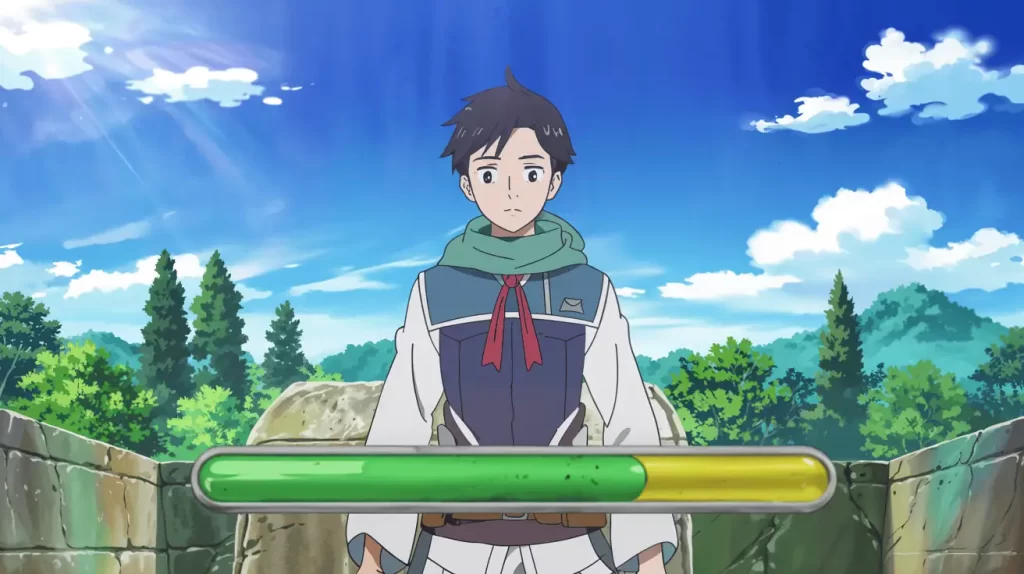
Wrap-Up
Loss and Avoidance, when done right, isn’t about fear. It’s about motivation with meaning. Students don’t want to fall behind—they want to belong, contribute, and grow.
As teachers, you get to shape systems that lean into this drive with compassion and strategy. When done right, Octalysis Framework Core Drive 8 becomes your classroom’s not-so-secret superpower.
Want to build systems that actually motivate and empower your learners? Start here. Start small. And let Core Drive 8 do the rest.
Want to explore more ways to motivate your students with Octalysis Framework?
Visit the Ultimate Guide to Octalysis Framework.
This comprehensive guide provides an overview of the entire framework and links out to more posts exactly like this one to guide you through all 8 Octalysis Framework Core Drives and even more!
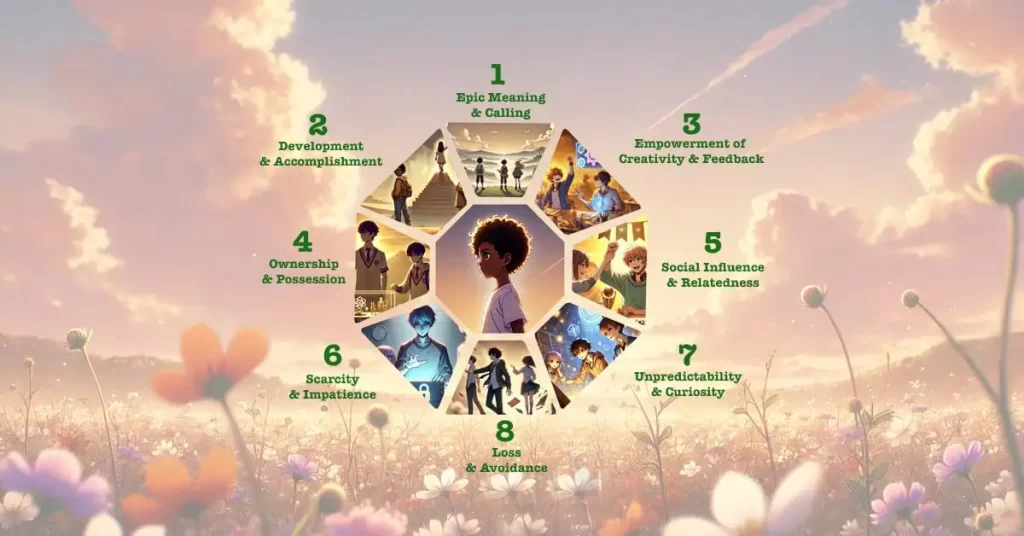
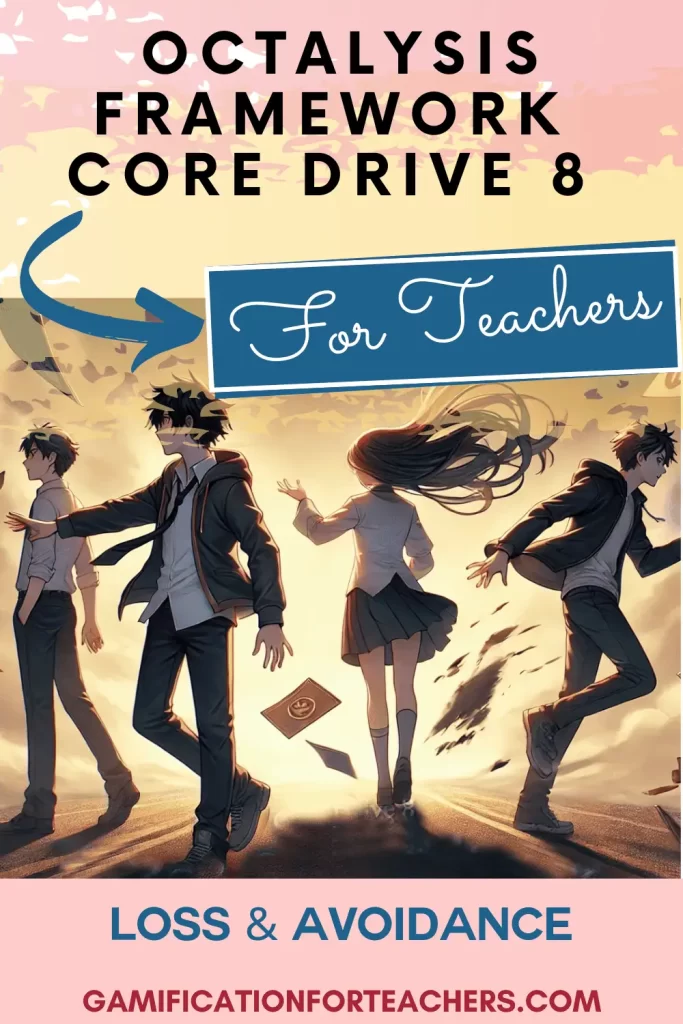
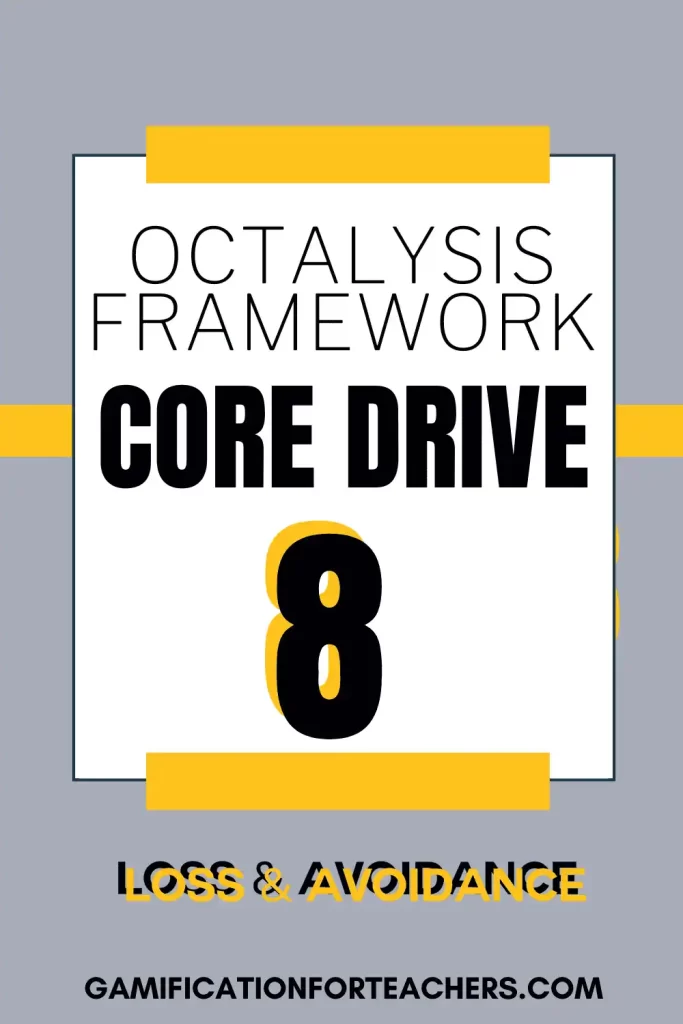
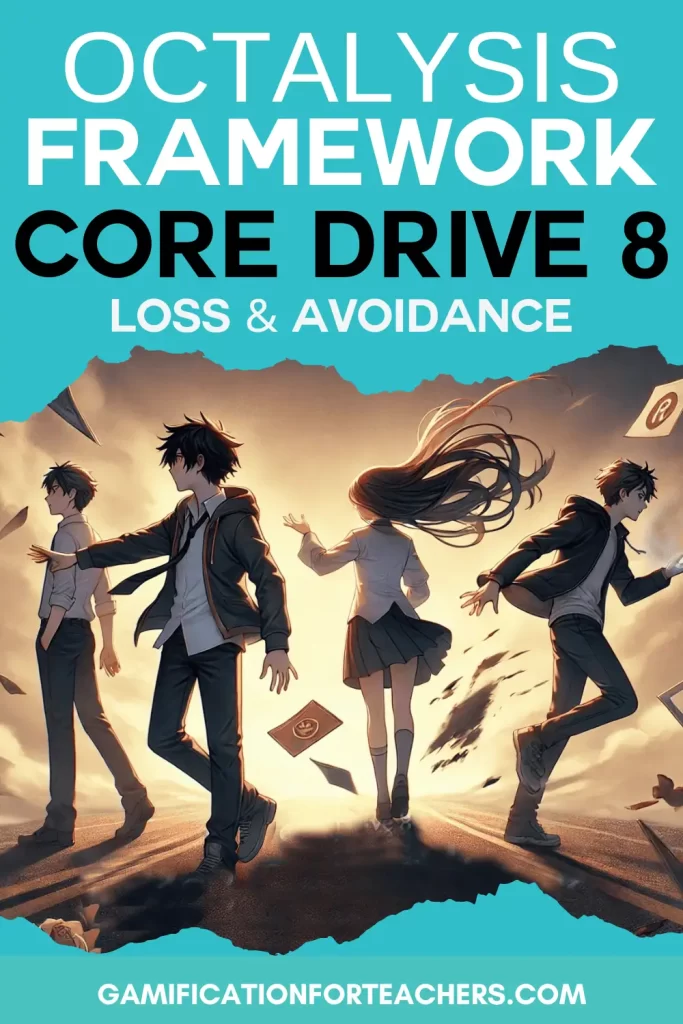
🎮 Octalysis Framework Core Drive 8 – Loss & Avoidance FAQs
Isn’t this just fear-based motivation?
It can be, but it doesn’t have to be scary or shame-y. When used thoughtfully, it’s about helping students value their progress and avoid regret, not punishment. Think: “Don’t lose your streak!” — not “Do this or else.”
How can I use this without stressing students out?
Use it gently. Try framing things around positive accountability:
“Keep your badge!”
“Don’t lose team points!”
“You’re so close to unlocking that next level!”
It’s about nudging, not pressuring.
Isn’t this the opposite of growth mindset?
Only if it’s used to shame failure. But when framed as protecting progress or avoiding missed opportunities, it actually reinforces ownership and intrinsic motivation. You’re helping students see their effort as worth protecting.
What are some classroom-friendly examples?
Glad you asked:
Streak rewards (for turning in homework, positive behavior, etc.)
Team point systems where points can be lost for missing deadlines
Time-limited challenges that expire if not completed
Locker of Lost Privileges (aka the coolest stuff they almost earned 👀)
How do I keep it fair for students who need extra time or support?
Build in flexibility! Let students “recover” points, regain streaks, or retry challenges. Loss can be motivating, but redemption is where the real learning happens.







